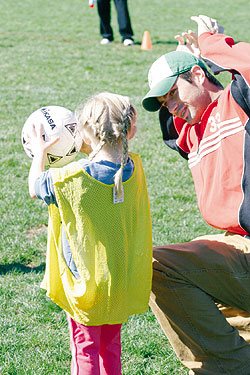 | |
|
Brandon Clougherty '05 teaches Samantha Amidon the overhead throw.
|
The Wabash team won’t take to the pitch at Mud Hollow Field for another four hours, but Perry is setting out cones and retrieving a large box of pint-sized soccer balls from the storage shed at the far end of the field. Samantha starts running toward him: "George!" She leaps at the fourth-year soccer coach and he grabs her in his arms and asks if she’s ready for her big game. Samantha smiles, kisses him on the cheek, and says, "Yes."
Perry is one of several new coaches at Wabash who has brought with him to the College a strong desire to connect with the larger community, especially its youth. When he arrived in Crawfordsville he attached himself—and his Wabash team—to the Boys and Girls Club’s youth soccer program. What will take place at Mud Hollow for the next 90 minutes is nothing short of remarkable: 70 families—some Wabash, but most not—will descend on Mud Hollow with their four, five, and six year-old kids to take part in what Perry calls "Micro Soccer." The idea is to teach these youngsters the basics and enjoyment of the game, with Wabash junior varsity and varsity players serving as clinicians and role models.
"This kind of program needs as many parents as possible," says Perry, "but since there are so few people here in Crawfordsville who know much about soccer, especially, the under-six mentality, it was difficult to keep things going at the Boys and Girls Club. By moving the program to Wabash, we have been able to get more of our players involved and get some of the under-six families to attend our games."
For the first 30 minutes the kids work with the Wabash players.
"This is where Wabash players have a huge impact," says Perry. "They get to work one-on-one with the kids, teaching them skills, encouraging their effort, and challenging them to do their best."
The kids then break up into their 10 teams of six to eight players for non-competitive games. They play on tiny fields where each player is more likely to touch the ball. Score isn’t kept, there are no goalkeepers, and because the fields are small, there’s more stoppage for balls kicked out of bounds than there is action. Perry points out that such breaks allow for more interaction and instruction.
My wife and I call the games "caterpillar" because the kid with the ball is chased, in line, down the field like a human caterpillar. The parents surround the field, laughing as much as cheering. And to a person, the kids are having a blast. And when it’s all over, the Wabash soccer players teach the youngsters about sportsmanship as the two opposing teams shake hands and share snacks.
Perry and assistant coach Bobby Horton, a psychology professor who manages the program when the Wabash varsity team is on the road, are not alone in their outreach efforts. Coach Chris Creighton and the football team are three years into their community service initiatives, which range from feeding the hungry people of Montgomery County to buying toys for underprivileged kids in town. The signature event for the football team, though, is the Youth Football Clinic.
"Youth Day gives the kids of Montgomery County an afternoon of fun playing with our players," says Creighton. "I remember meeting some college football players when I was a kid and I loved it; if I could have practiced with them and spent time with them, I would have thought I was in heaven. We hope that the kids who come to Youth Day have a similar experience. I am biased but I think our players are some of the finest role models a kid could have."
The clinic starts after an abbreviated Friday afternoon practice and attracts more than 100 kids from Central Indiana ranging from four years old to teenaged. Wabash players set up drill stations at Hollett Stadium and hand the kids their game jerseys while simultaneously teaching, coaching, and cheering for them. Everyone enjoys the event, which ends with each kid running through a "tunnel" of Wabash players on a mock break-away touchdown run.
"Youth Day is good for our players, too," adds Creighton. "They enjoy the experience, and, being with the kids on Youth Day has inspired some of them to pursue working with kids as a career."
New swimming coach Peter Casares has continued Gail Pebworth’s long tradition of offering swimming lessons to local youth. The spots in the classes fill up quickly since each participant is paired with a Wabash swimmer for one-on-one personal attention. In many cases, those lessons are the first time the kids have ever been in the water, and the trust they place in the Little Giant tankers is simply staggering.
Wabash used to be a pretty lonely place in the summer, except for basketball coach Mac Petty’s occasional youth camps. Now the place is bustles with activity.
Coach Tom Flynn hosts a number of youth baseball camps; Perry puts on intense soccer clinics; wrestling coach Eric Reed joins the fun with kids learning the basics of wrestling. Similar camps and lessons are offered for tennis as well.
The biggest addition to the summer schedule, though, is a week-long segment of the nationally known Bishop-Dullaghan Passing Camp for football players, which attracts some of the top high school football players in the region.
The children who take part in the full range of camps and clinics, and who benefit from the fund raising and other outreach efforts, are given positive male role models. Wabash students get to do something they really love is reaping great rewards for the College and for the community.